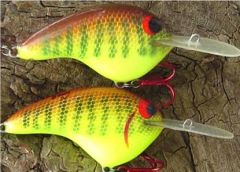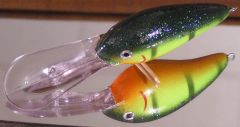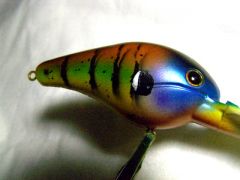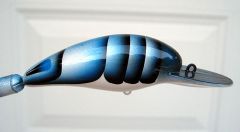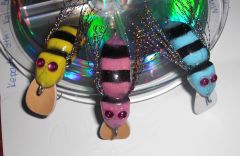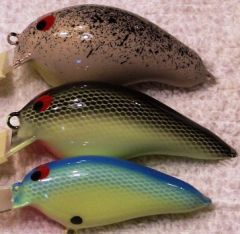-
Posts
1,752 -
Joined
-
Last visited
-
Days Won
1
Content Type
Profiles
Articles
TU Classifieds
Glossary
Website Links
Forums
Gallery
Store
Everything posted by Lure--Prof
-
Hello Baitmaker! Your advice, Try to stir in only one direction and never stir briskly. Mix for at least 30 seconds. and tips work for Devcon 2-ton and other quick cure epoxies, but Envirotex-Lite will simply never get mixed unless it is mixed briskly, especially in the larger quantities in which E-tex is normally mixed, because of its much longer pot life, which allows one to coat several lures at a time. E-Tex's own instructions advise that their product should be whipped, and with the longer mixing time required it is easy to end up with an even distribution of very fine bubbles after thorough mixing that can be quite frustrating to get rid of...much easier not produce any to begin with. My method of using the round wire on the concave can bottom worked so well with E-tex that I began using it for all of my epoxies, including for small amounts of bubble-free 2-ton for gluing lips. Because the mixing tool matches the shape of the mixing surface, the chances of leaving any epoxy unmixed is greatly reduced. Total clean-up is quick and easy, and there is no more buying of cups just to throw away. (think green!) Good fishing, Dean
-
I doubt that the fish will think that it will need much of anything--That is a great basic color--You could add some details, such as gill flap spot, like a bluegill, or shad type "false" eye, popularly known here as a "kill-spot". On most of my baitfish-type cranks, I add a red gill-indicator swoop, or slash, or "quarter moon". A lot of guys add a bit of detail surrounding the eye like a bit of dark mist, just add a bit of dimension to it. I often add a bit of transparent red at the nose and throat, which will on your bait, fade in a touch purple on the nose. Like I say, ol' blue and chartreuse needs nothing else to be effective...but it's easy to spice it up a bit, and it may help under certain conditions, particularly in clear water. Don't be afraid to experiment with layering bits of other colors, like a bit of silver scale work on the shoulders for instance, which will add depth and dimension to your paint jobs. And remember that a little paint will be magnified when the clearcoat hits it, so use a light touch when adding accent shading. Go for it & Good Luck! Dean
-
Thanks Rob, I'm keeping it 'tween the fences buddy, I appreciate the good wishes! I like it when the fish insist you build certain baits. So far it has been an odd fishing fall this year; with all of the rain we've had, (all the fronts don't help the pain issues) there's not nearly as much oxygen depletion taking place with turnover, and lake levels are higher than normal, keeping the fish more scattered than typical...Is it kind of the same down your way? I really appreciate the compliments Rob as you are one of the great home-production builders (and a dedicated Urethane clearcoater)!! Yours, Dean
-
I'll remind you of this tomorrow when you ask me a question that is answered in this post. Dean
-
-
I agree with the above. Heating your sealed lure slightly beforehand may help epoxy flow onto the bait too. With all clearcoats there is a learning curve, just like there is with every other aspect of lure building, and often we use slightly different methods to achieve the same end. With that in mind, I use epoxies for sealing my lures, and on top of my foil baits. My final clearcoat on all my lures, big and small, sharply and intricately carved or smooth and relatively featureless, is Dicknite's Topcoat. This part is not just my opinion: It is by far the best performing clear coat I've ever used. Said another way, nothing I've used protects my lures, and keeps them looking their best, better than Dicknite's Lurecoat Topcoat. I want my lures to perform as well as my fishing experience and lure making can make them, I want them to look good, and I want them to last as long as I can make them last. I use the best split rings and hooks I can buy: The hooks vary among premium brands according to lure type and probable line usage. The split rings are Owner: Their true-sized # 3 is 45 pound test; their small size, 2, is 37#, and their 4 is 50#, and they are all sized the same as regular, not HD stainless rings. They're expensive, but the best. A little more specifically on-topic, if you are going to heat epoxy at all as a clear coat, the lure must be thoroughly sealed, particularly balsa. Unsealed wood when heated even a slight amount will cause bubbles to form in your clearcoat. To mix any clearcoat thoroughly and relatively bubble free, here is what I do: I use the bottom of an aerosol can, cleaned with a slovent of any ink as my mixing surface. I measure, by volume, not weight, equal parts. I use a piece of wire bent into a circle as my mixing tool. The ends of the wire are tied to each other with enough loops and twists, big enough and with enough wire to give a good gripping surface. The wire conforms to a portion of the concave can bottom, ensuring that nothing gets missed. Slide the wire against the can bottom's surface slowly into the epoxy. I begin to mix, using both circular and back and forth motions, and I mix aggressively, particulary E-tex, which must be thorough. Mix and mix and mix, Never removing, or lifting the wire from the can bottom until you are finished. With a little practice, you're on your way to minimizing mixing bubbles. Brushing and exhaling should remove the rest. I place my upsidedown can into a glass jar for stability. I clean all my tools as soon as I'm finished coating, which is easily done with alcohol or acetone. Even stiff epoxy can easily be cleaned from the can bottom by pouring alcohol on top of it and scraping with a rounded circuit board lure lip. The epoxy will stick to itself on the scraper and can be easily removed with a paper towel and alcohol. In addition, I find that my old 1rpm dryer works on E-tex and Devcon equally well. I normally let my E-tex sit for 10 minues before using it, during which time it will thicken slightly, and most bubbles will either self-expell or move close enough to the surface to be exhaled out of the puddle by moving the can slightly side to side. Some don't wait 10 minutes. That's okay too. David Sullivan and I have written extensively on Dicknite's topcoat use and storage in Hardbaits, and a little searching will easily yield everything you need to know. David and I both think that DN is just about a no-branier to apply, much simpler and faster than epoxy, as long as you don't try to apply it like epoxy! Paint the lure wet with DN, and you are done. If, five minutes after you finish, you find you've missed a spot, then just catch it on the next coat. I personally think that the "storage issues" about DN are way overblown! David uses a "Tap the Keg" method, by threading a sheet metal screw into can, while I decant into smaller containers and seal them after filling replacing any dead air space in them with Bloxygen Finish Preserver (available by ordering from Woodcraft, and other outlets). I use this on my "working" 1/2 ounce jars also, giving them a shot before resealing them. No air, no finish degradation. I can clearcoat half a dozen lures and clean up and put up much quicker with DN than I can epoxy, with less mess. This is important when my wife says, "supper in 10 minutes!" There are no measuring mistakes to make, and I use 100% of the product now. My wife likes the smell. Your method for mixing epoxy may well be different from mine. But I can mix mine free of bubbles 8 times out of ten, and remove whatever bubbles are there after mixing the other 2 times. I hope this answers a question or three. Dean
-
-
2--Ton may indeed have more actual gloss or shine on its own, simply because it isn't as clear as DN. It does not have the literal water-clarity that Dicknite's has. And you said there are many, many, 2-part moisture clear urethanes that are as good as Dicknite's. That sounds like a lot of products with which you've had extensive experience. If you'd like to share, we're always ready to learn. Dean
-
-
-
-
BobP, as Frchkn said heat is the catalyst, without which certain paints like Createx won't cure. These same paints are used on textiles such as t-shirts, and heat setting them in a clothes dryer is necessary to make them permanent so they won't wash out. Without heat setting the colors will wash out. Same deal with lures, the paint will wash off without heat setting and won't after heat setting; of course everyone uses a decent clearcoat to make them more durable than laundry needs to be... I build my baits to take high heat, without splitting, or bubbling, which isn't hard to do--Sealing the wood with an epoxy clear coat, and using epoxy to glue in ballast, pretty much heat proofs most lures, which is not a bad idea, when you leave lures lying out on the deck bare or in a clear plastic box on 100 degree days. And as Gunnie says, it is necessary to heat set Createx to make it solvent-proof if you're clearing with a urethane such as Dicknite's, which is how I've been building mine for the last 3 years. However I can't say about Wildlife Colors; I do know a friend of mine had some compatibility issues with a couple of clearcoats with Wildlife Colors. Dean
-
I appreciate the nice comments everyone! Boone buddy those are some fine jumpers you're holding there!! Stringjam, I have a blue MIM Strat that I put a perloid pg on, but mine's has a maple board. I have MIA rosewood board Strat, but it's an HSS Sienna Sunburst... I just make them as well as I know how---I like them to last as long as possible. As soon as I figure out how to make circuit board as durable as Lexan, I'll spread the word!
-
Personally, if I could not use Dicknite's, I would find another moisture cure urethane for clearcoats. In my opinion, its total performance is far superior to any epoxy for the battering my baits take in woody cover. I've done a lot of repair to epoxy covered baits. And I'm not here to argue, but simply to help people who are interested in building lures. I don't advocate one clear coat over another unless someone wants to know what, in my experience I think is best. I pay the same for my coatings as everyone else does, and I use all of them in some capacity, including 3 different epoxies, and there will probably be more in the future. As far as storage goes, David and I use 2 different systems, and we're both happy. I brush on 3 or 4 coats of fresh Dicknite's topcoat. I enjoy using this particular product just like David says, because of total confidence in its performance, and ease of use. And I mix my epoxy bubble free which I learned to do after lots of epoxy mixing. I still find storing and using Dicknite's much easier than using epoxy. Probably my biggest issue with epoxy is attempting to coat lures which have sharp angles on them, and maintaining an even coating thickness, or with crankbaits, ending up with more epoxy on the lip than on the nose of the bait. With Dicknite's, or another urethane, it is much easier to apply a uniform thickness and have it dry that way. Try carving your first cup-faced popper and clearing it with epoxy. Nigh on impossible to cover the sharp cup edge---and we know what happens when water gets under epoxy. But Gunnie, to tell David and many others who have switched from 2-ton to Dicknite's topcoat, many of whom were here and gone long before you joined, that our observations are wrong, that what I've seen with my own eyes as a longtime diehard fisherman (and at least one Elite Series Pro) in the last three years is incorrect, I find almost funny, and fairly rude. Your opinion is your opinion, and you can find suppporters, for sure, but if it was a stone cold fact, everyone would use 2-ton. We ain't stupid, and you're saying we either are, or are wrong or both. My experience tells me that Dicknite's is the best clear coat I can use to make the best lures I can make for my use, and that is my wherefore and why. Dean
-
That's what I need: some clear paint, especially for my pine propbaits! Sorry, Dean
-
-
-
-
diemai, thanks so much, those pattterns are my versions of an old Bagley Baits pattern that I caught a lot of bass on. I first began learning to paint it out of necessity a few years back when there was no Bagley Company around anymore. The company has since been ressurrected under new ownership Their original color vairied some bait to bait on the amount of brown, the heaviness of the black or dark gray bars, and the amount of flourescent yellow on the sides and orange on the belly. These particular baits have no orange, and I play with the brown back color too, sometimes with a little blue or yellow or red, but these are Createx light brown sprayed on the hot yellow. Spoopa, thanks again for your comments and compliments, I really appreciate them. I don't make a lot of baits anymore, but I take my time and make them as well as I can. They sure do last longer when you do that! I've been fortunate not to lose that top one in the yellow crawfish color as I have actually broken it off with a baitknocker twice, but it floated up. I've caught a lot of fish on it too, and it is a bit scratched and scuffed from toothmarks etc, but I'll just renew it with some sanding and a coat of clear this winter. I built the bottom one for a back-up! Capt., Not a very good picture on the shad color bait, because it is at an angle that shows the scales, but not the bright silver highlights, and you know what I'm talking about! Thanks much for the kind words friend! Dean
-
Black with a little glitter, white with a little glitter and/or with a black or blue back; and yellows for sunfish or perch, are standard topwater colors that have worked for many many years. You can embellish from there. Dean
-
The shad color bait is epoxy sealed, Createx paint, 4 coats of brushed Dicknite's Clear Topcoat, Fully tied straight-pull single piece stainless wire 3-point harness, lure body is a single piece of 1/2 inch balsa, with a circuit board lip. The chartreuse-crawfish twins are made sandwhich style using 2 pieces of balsa each, but are otherwise the same besides having slightly smaller lips.. Nothing like fishing custom lures that are built for specific lakes and conditions!
-
The shad color bait is epoxy sealed, Createx paint, 4 coats of brushed Dicknite's Clear Topcoat, Fully tied straight-pull single piece stainless wire 3-point harness, lure body is a single piece of 1/2 inch balsa, with a circuit board lip. The chartreuse-crawfish twins are made sandwhich style using 2 pieces of balsa each, but are otherwise the same besides having slightly smaller lips.. Nothing like fishing custom lures that are built for specific lakes and conditions!
-




